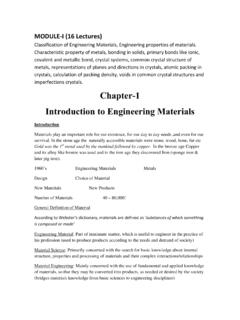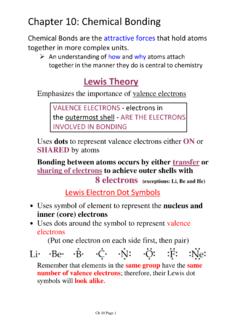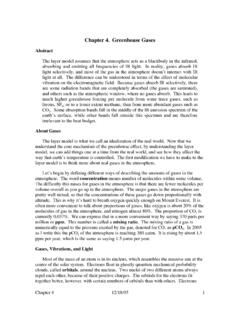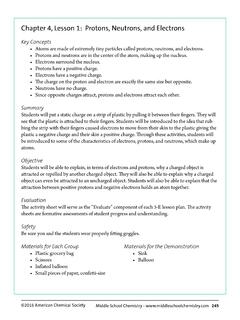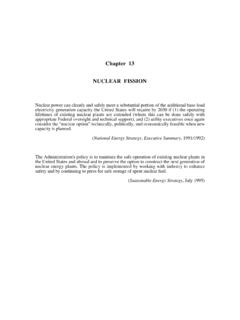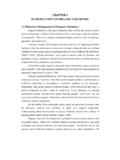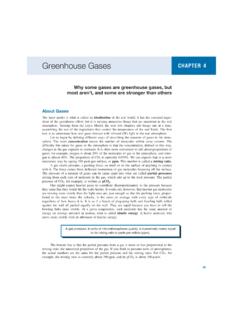Chapter 4 Understanding The Atom
Found 10 free book(s)SSSTRUCTURE OFOFOF THETHETHE A A ATOMTOMTOM
www.ncert.nic.inChapter 3, which suggested that the atom was indivisible and indestructible. But the discovery of two fundamental particles (electrons and protons) inside the atom, led to the failur e of this aspect of Dalton’s atomic theory. It was then considered necessary to know how electr ons and pr otons ar e arranged within an atom. For explaining ...
Chapter-1 Introduction to Engineering Materials
www.bput.ac.inChapter-1 Introduction to Engineering Materials Introduction ... ¾ Unit cell has an atom at each of twelve corners of hexagonal prism, with one atom at centre of each of two hexagonal faces and three atoms in body of cell ... SC structure is chosen for understanding
Chapter 10: Chemical Bonding
webs.anokaramsey.eduAn understanding of how and why atoms attach ... Chapter 10: Chemical Bonding Ch 10 Page 1 . Noble gases are considered stable because they do not ... Ch 10 Page 4 . 1. Decide on the central atom (it will never be H or F). (The central atom is usually the one that is by itself)
Chapter 4. Greenhouse Gases - University of Chicago
forecast.uchicago.eduChapter 4 12/18/05 1 Chapter 4. Greenhouse Gases Abstract ... by understanding the layer model, we can add things one at a time from the real world, and see how they affect the ... has one atom of each element, and as a result has a slight imbalance in its distribution of
Chapter 4, Lesson 1: Protons, Neutrons, and Electrons
www.middleschoolchemistry.comChapter 4, Lesson 1: Protons, Neutrons, and Electrons ... sheets are formative assessments of student progress and understanding. Safety Be sure you and the students wear properly ˆ˜ing goggles. ... the atom from Chapter 3 but reviewing the main points is probably a good idea.
Chapter 13 NUCLEAR FISSION
personal.ems.psu.eduChapter 13 NUCLEAR FISSION ... atom (nucleus) reacts with a neutron, becomes temporarily unstable and is fragmented very soon thereafter into a nucleus of barium (Ba) and a nucleus of krypton (Kr). ... process is the key to understanding the difference between a …
CHAPTER 1 INTRODUCTION TO ORGANIC CHEMISTRY 1.1 …
www.siue.eduCHAPTER 1 INTRODUCTION TO ORGANIC CHEMISTRY ... Understanding about the structures of organic chemistry began with a theory of bonding called valence theory (Kekule, Couper, 1858). ... atom receives an electron to form a …
CHEMICAL BONDING AND MOLECULAR STRUCTURE
ncert.nic.inUNIT 4 After studying this Unit, you will be ... understanding of the structure of atom, the electronic configuration of elements and the periodic table. Every system tends to be more stable and bonding is nature’s way of lowering the energy of the system to attain stabi lit y.
Chapter 1 Introduction to Earth Science
www.fusd1.orgChapter 2 Minerals Summary 2.1 Matter An element is a substance that cannot be broken down into simpler substances by chemical or physical means. An atom is the smallest particle of matter that contains the characteristics of an element. • The central region of an atom is called the nucleus. The nucleus contains protons and neutrons.
Greenhouse Gases CHAPTER 4 - University of Chicago
forecast.uchicago.edu32 CHAPTER 4 Greenhouse Gases O HH δ+ δ+ 2δ− Resting state O H O H Symmetric stretch Bend 3657 cm −11594 cm Figure 4-2 Vibrational modes of a water molecule that interact with infrared light in the atmosphere. The other vibrational mode is an asymmetric stretch, in which one bond is growing longer as the other gets shorter, back and forth.

